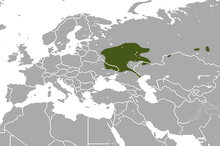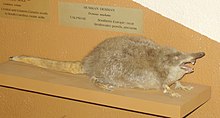This is an old revision of this page, as edited by UtherSRG (talk | contribs) at 12:38, 11 December 2023 (→top: update IUCN ref). The present address (URL) is a permanent link to this revision, which may differ significantly from the current revision.
Revision as of 12:38, 11 December 2023 by UtherSRG (talk | contribs) (→top: update IUCN ref)(diff) ← Previous revision | Latest revision (diff) | Newer revision → (diff) Species of mammal
| Russian desman | |
|---|---|

| |
| Conservation status | |
 Critically Endangered (IUCN 3.1) | |
| Scientific classification | |
| Domain: | Eukaryota |
| Kingdom: | Animalia |
| Phylum: | Chordata |
| Class: | Mammalia |
| Order: | Eulipotyphla |
| Family: | Talpidae |
| Genus: | Desmana |
| Species: | D. moschata |
| Binomial name | |
| Desmana moschata (Linnaeus, 1758) | |

| |
| Russian desman range | |
| Synonyms | |
|
Castor moschatus Linnaeus, 1758 | |
The Russian desman (Desmana moschata) (Template:Lang-ru vykhukhol') is a small semiaquatic mammal that inhabits the Volga, Don and Ural River basins in Russia, Ukraine and Kazakhstan. It constructs burrows into the banks of ponds and slow-moving streams, but prefers small, overgrown ponds with abundance of insects, crayfish and amphibians. The Russian desman often lives in small groups of two to five animals, that are usually not related, and appears to have a complex (but largely unstudied) communication and social system.
Taxonomy


The Russian desman is one of two surviving species of the tribe Desmanini, the other being the Pyrenean desman. Despite its outward similarity to muskrats (a rodent), the Russian desman is actually part of the mole family Talpidae in the order Eulipotyphla. Like other moles, it is functionally blind and obtains much of its sensory input from the touch-sensitive Eimer's organs at the end of its long, bilobed snout. However, the hind feet are webbed and the tail is laterally flattened —specializations for its aquatic habitat. The body is 18 to 21 cm (7.1 to 8.3 in) long while the tail is 17 to 20 cm (6.7 to 7.9 in) in length. Easily the largest species of mole, it weighs 400 to 520 g (14 to 18 oz). Decidedly rich and thick in nature, desman fur used to be highly sought after by the fur trade. Consequently, the Russian desman is now a protected species under Russian law. However, due to loss of habitat (farming), water pollution, illegal fishing nets, and the introduction of non-native species like muskrat, population levels continue to decline. In the mid-1970s, an estimated 70,000 desmans were left in the wild; by 2004, the figure was only 35,000. However, in some Russian regions, the number of desmans appears to be increasing.
Distribution and habitat
From 2009 to 2011, the Don Basin rivers were searched for Russian desman to evaluate if this environment was sustainable for the species. No evidence was found that the species lives in this area but if so, the population was very small. The limiting factors consist of global factors, interspecific processes, and new immigrating species in the river ecosystem.
Characteristics
Russian desman provide comfort to themselves by grooming. More specifically, scratching with hind feet, washing, biting out of nails, and biting out of fur. The main reasons for these actions are supporting the air layer and heat-insulating properties of fur.
References
- Hutterer, R. (2005). "Order Soricomorpha". In Wilson, D.E.; Reeder, D.M (eds.). Mammal Species of the World: A Taxonomic and Geographic Reference (3rd ed.). Johns Hopkins University Press. p. 303. ISBN 978-0-8018-8221-0. OCLC 62265494.
- Rutovskaya, M.; Gazzard, A.; Turvey, S.T. (2023). "Desmana moschata". IUCN Red List of Threatened Species. 2023: e.T6506A231334630. Retrieved 11 December 2023.
- Morelle, Rebecca (4 September 2012). "Pyrenean desman: On the trail of Europe's weirdest beast". BBC News.
- "Russians rally for water mammal". BBC News. 9 June 2006.
- Oparina, O. S.; Filinova, E. I.; Sonina, E. E.; Malinina, Y. A.; Oparin, M. L. (2013). "Current status of the Russian desman habitats in small rivers of the Don River Basin in Saratov oblast and the abundance of this species". Biology Bulletin. 40 (10): 854–861. doi:10.1134/S1062359013100075. S2CID 15623225.
- Makhotkina, K.A (March 2013). "COMFORT BEHAVIOR OF RUSSIAN DESMAN (DESMEVA MOSCHATA)". Zoologichesky Zhurnal. 92: 313–321 – via Science Citation Index.
External links
 Media related to Desmana moschata at Wikimedia Commons
Media related to Desmana moschata at Wikimedia Commons Data related to Desmana moschata at Wikispecies
Data related to Desmana moschata at Wikispecies- ARKive - images and movies of the Russian desman (Desmana moschata)
| Taxon identifiers | |
|---|---|
| Desmana moschata |
|